Full day of sessions! I have been able to participate to some really good and great sessions I would like to share with you.
Driving Impactful Business Results [KEY1866]
The day began with the keynote from Safra Catz.
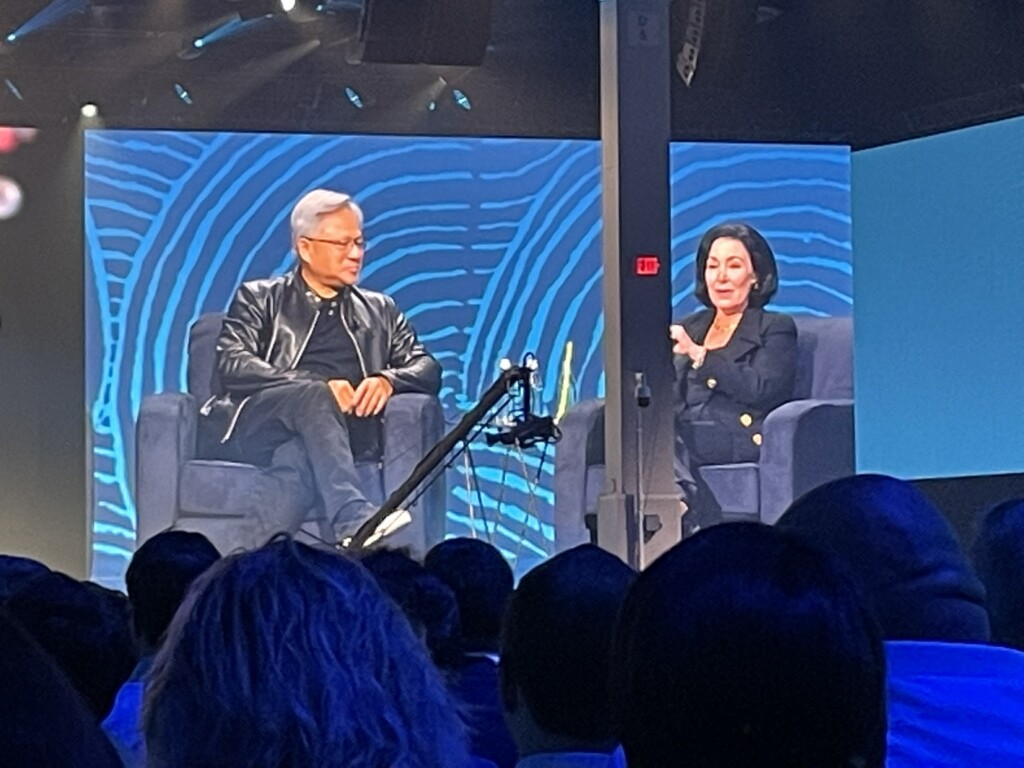
My first impression. Wow. We can see the work to organize such a session and how many people would have been helping on this session’s organization. Maybe one day I will be able to give a session in front of so many person, but I do not believe this will ever happened. xD The introduction show was amazing as well.
It was an interesting and dynamic session where Safra Catz, Oracle CEO, discussed with several leaders of global brands like NVIDIA, Deutsche bank, Grup Bimbo, Johnson controls, Melissa & Doug and finally Oracle Red Bull Racing. They explained and presented how they are solving the most complex problems with oracle.
These leaders highlighted how to decrease cost and energy consumption to do more for business. For NVIDIA challenge was to bring automatisation to OCI with AI. This in order to allow doing more without consumption more energy and without having more cost. Another important point is to continuously increase processing, demand, and modernise the infrastructure in mean time keeping the environment stable.
It has been mentioned how Exadata cloud at customer and OCI provides various capability at customer side, adding flexibility. It has been discussed that moving quickly is riskly but moving slowly is dangerous. “Innovation is scary but not risky. People got confused sometimes”, said Safra. Oracle cloud at customer project, provided advantages in the cost and availability. It has been explained how innovation is important to have better products.
OCI Tutorial—OCI Technical Quick Start [TUT4110]
I then had the pleasure to follow an interesting 2 hours session with Uma Kumar, Joey Hall and Creighton Swank from Oracle.
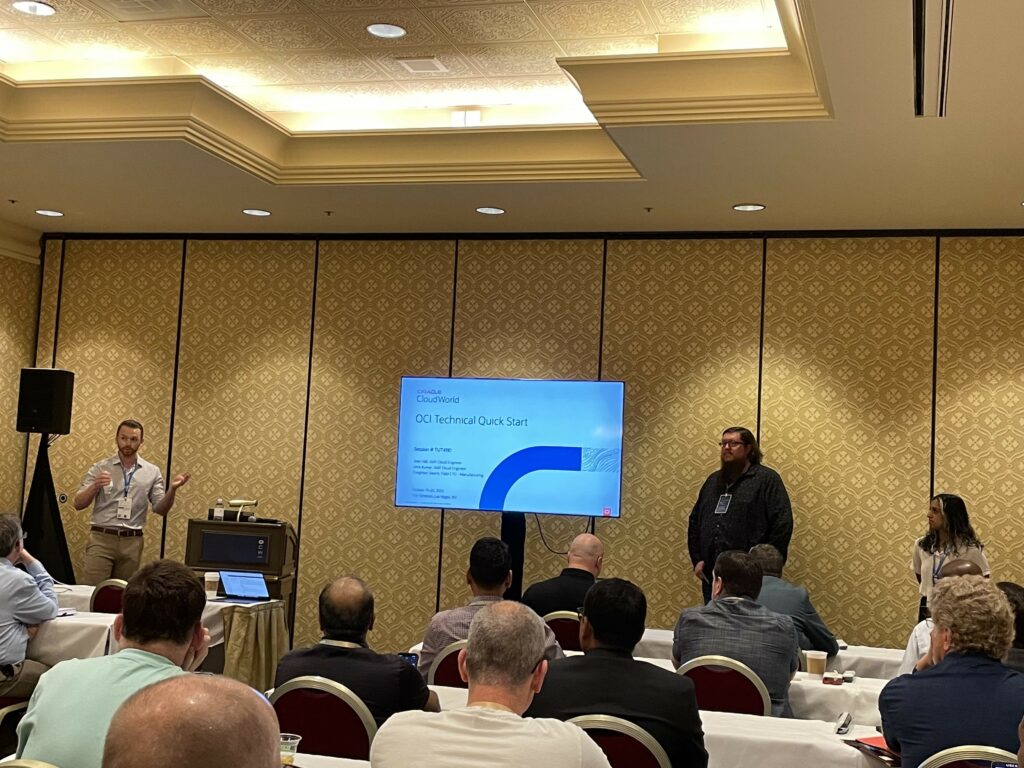
I really enjoyed it! They provided some demos, and I like people doing session with demos. I also liked the interaction of the group and the availability and great experience of the speakers to answer the questions on live. The purpose of the session was to get the foundational knowledge needed to begin building in OCI tenancy.
The speakers introduced the foundations to OCI and what are the various responsibilities for on-premises IaaS, PaaS, SaaS.
OCI has got currently 40 regions, 12 interconnect regions with azure (partnership). This allows to have 1 to 2 ms latency only between the 2 cloud solutions.
We then had a nice explanation on what is behind the scenes of an OCI Region. Introduction of Availability Domain, Fault Domain grouping Hardware, predicable low latency and high speed, encrypted interconnect between ADs has been addressed. Most important to remember : Region -> AD -> fault domain.
Tenancy is the top level account. I was also wondering why would a customer get more tenancy when thy can create compartment. And I could ask and get the answer. It is just a matter of getting more secure segregation.
We got a well and clear introduction from all the component of the OCI, from IAM, to storage going through compute and networking.
There were additional great discussions on compartment used to group OCI resources. Root compartment been the highest level.
Explanation on how to setup policies has been provided. Policies are attached to either the tenancy or compartment. Where you attach it defines who can modify it or delete it.
Permissions are given on groups. Policy gives the autorization to a group to perform actions.
Monitoring and managing the OCI resources :
- Monitoring
- Logging
- Notifications/alarms
- Resource Manager
We got a great demonstration on how to create users, groups and policies.
We discussed how to set up a network in OCI. Here are the networking parts :
- VNC
- Subnet
- Gateways
- Load balancing
- DNS
- Fast Connect
A good recommendation would be not to apply any public IP Address to the compute instance but to go through a load balancer having a public IP address.
Discuss about the difference on the 4 existing gateways :
- Internet Gateway
- NAT Gateway
- Dynamic routing gateway
- Servie Gateway
We also discussed about the various of compute instance:
- Bare Metal
- Virtual Machines
- Containers
- Functions
The storing information in OCI :
- Local NVMe
- Block
- File
- Object/archive
And how to choosing the right database based on the workload :
- Oracle DB on compute
- Oracle Database Cloud Service
- Oracle Exadata
- ADW/ATP (Oracle Autnomous Database)
We finalised the session with a Demonstration on how to create a VCN.
Solving the Most Complex Problems Across Industries [KEY1869]
First time for me to have the opportunity to watch an onsite presentation from Larry Ellison.
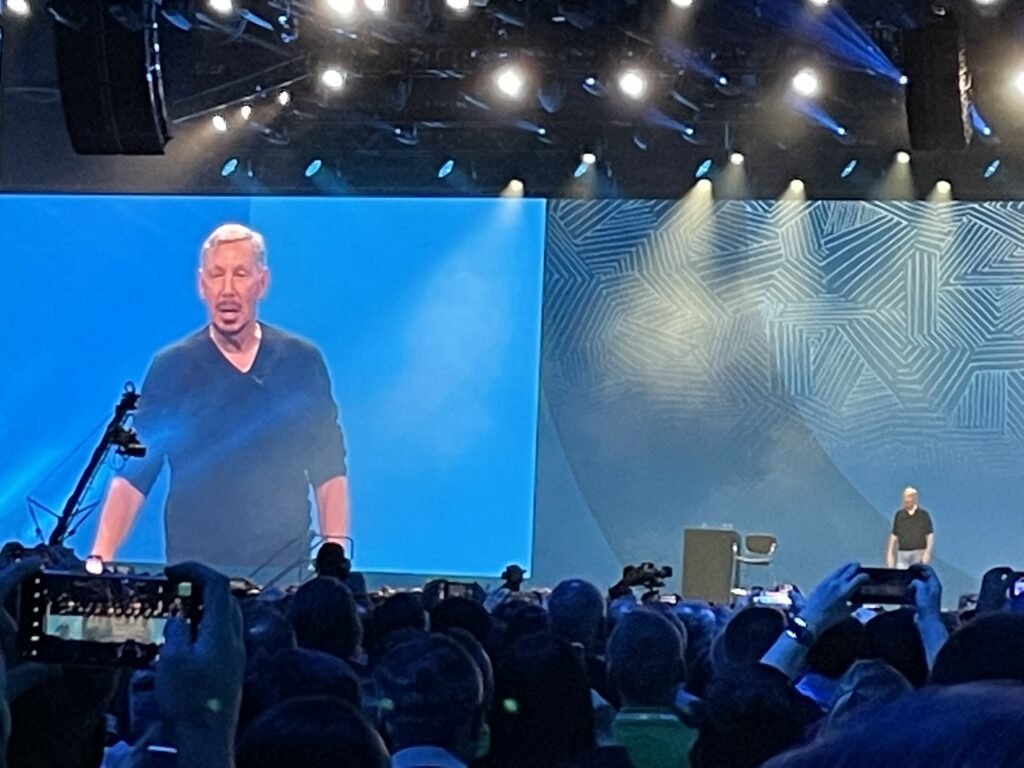
Larry Ellison stated that most of the customer use multiple cloud infrastructure and are ready to work with several of them. The new infrastructure services run on multiple cloud. This is why mysql is now available not only for oracle cloud but for all cloud infrastructure
I learn that moving data out from a cloud provider like AWS gives a taxe : ZERO Data Ingress/Egress fees. On the other hand Microsoft/oracle made some partnership and data transfer between both provider would be free of charge. An application in azure can use data in oracle cloud database free of charge and with a fast connection. From Oracle cloud we can also connect services in azure.
Oracle MySQL Heatwave in AWS run queries 10x to 100x faster than AWS Mysql Aurora.
As stated Microsoft and Oracle Clouds are interconnected. Applications running in Azure can connect to exadata RAC Database in oracle Cloud. Applications running in Azure can connect to Oracle Cloud MySQL Heatwave Database Microsoft Azure Customers can easily try it and see for themselves.
Larry Ellison spoke also about several Industries Applications related to health care. Purpose is to automate healthcare ecosystems end to end for patient to get a better experience. Oracle started building next generation healthcare applications during COVID 19 pandemic.
Those application are using :
- Autonomous Database : No Human Labor and no Human error
- APEX Low-code development : Built-in security and fault tolerance
v-safe (covid 19 vaccine information system) and GPAS (COVID19 global pathogen analysis system) proved huge applications development productivity gains.
Oracle is a leading provider of clinical trial systems.
Oracle Maximum Availability Architecture (MAA) Best Practices for OCI [LRN1472]
I had then the chance to follow a session from Glen Hawkins and Lawence To about MAA Best Practices.
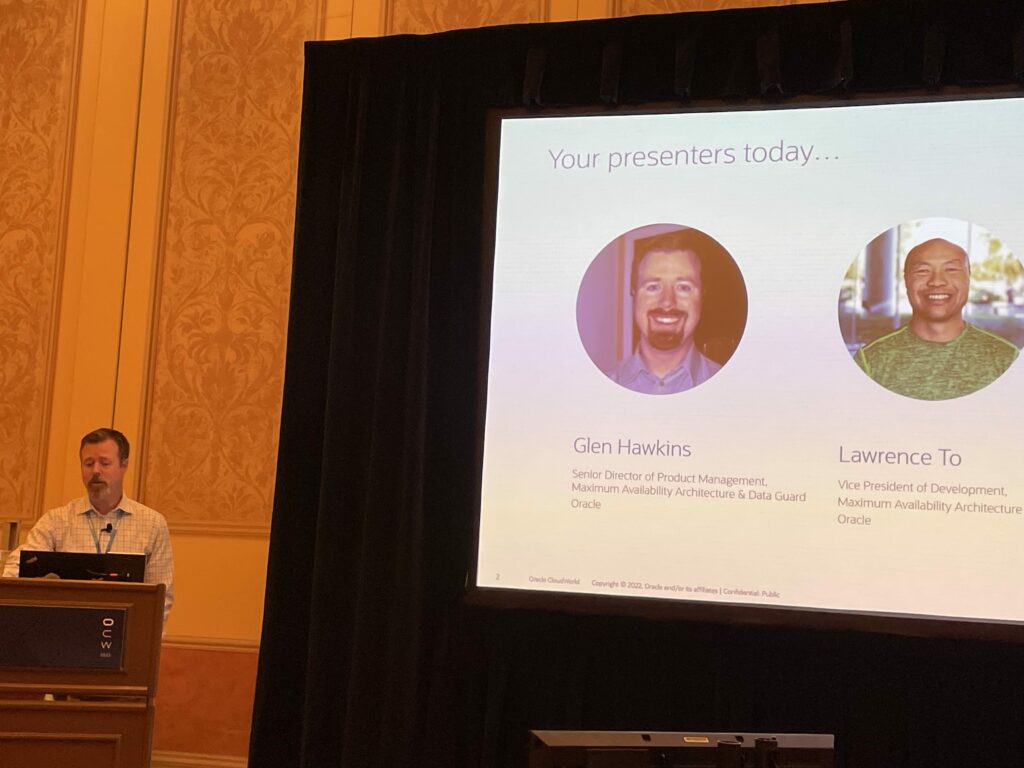
Types of downtime:
- Planned maintenance
- Upgrade
- Recoverable local failure
- Unrecoverale or site failure
The important term to understand for MAA is :
RTO (Recovery Time) : How much downtime
RPO (Recovery Point/Data Loss) : How much dataloss
Purpose of MAA is to reduce dowtime.
RAC, DG, Golden Gate are such applications making MAA possible.
Zero downtime migration with Golden Gate.
We started with an introduction to Cloud terminology. BTW I liked this slides :
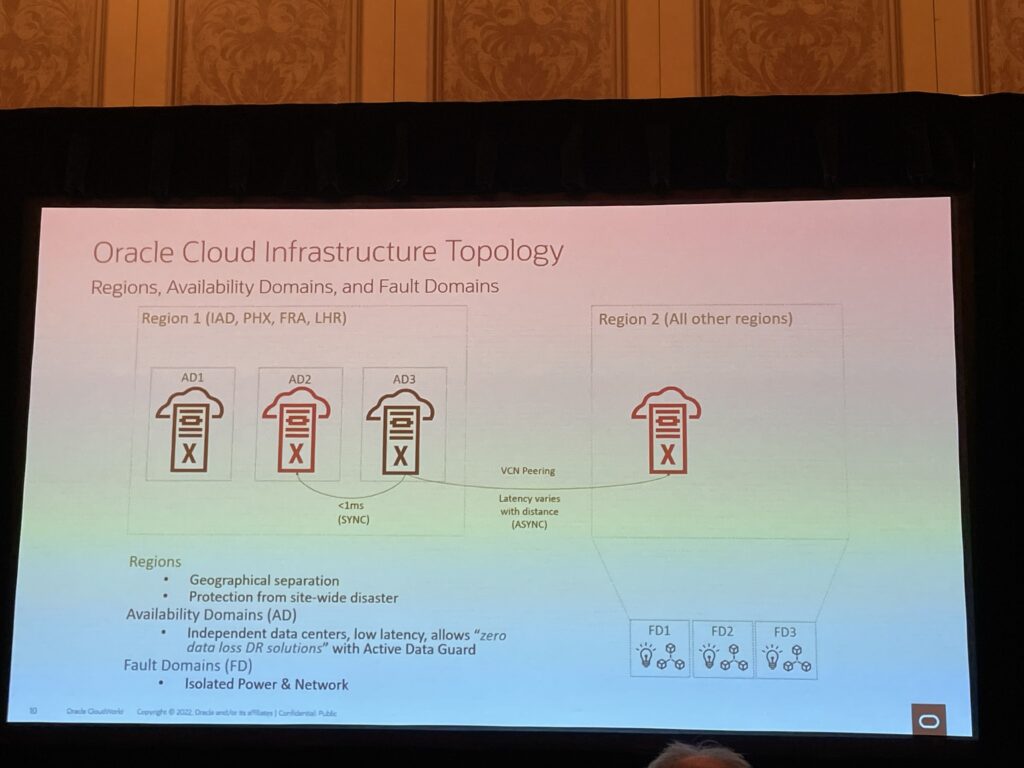
Following 5 slides best explain MAA from single Instance to 99.999% (5 nines):
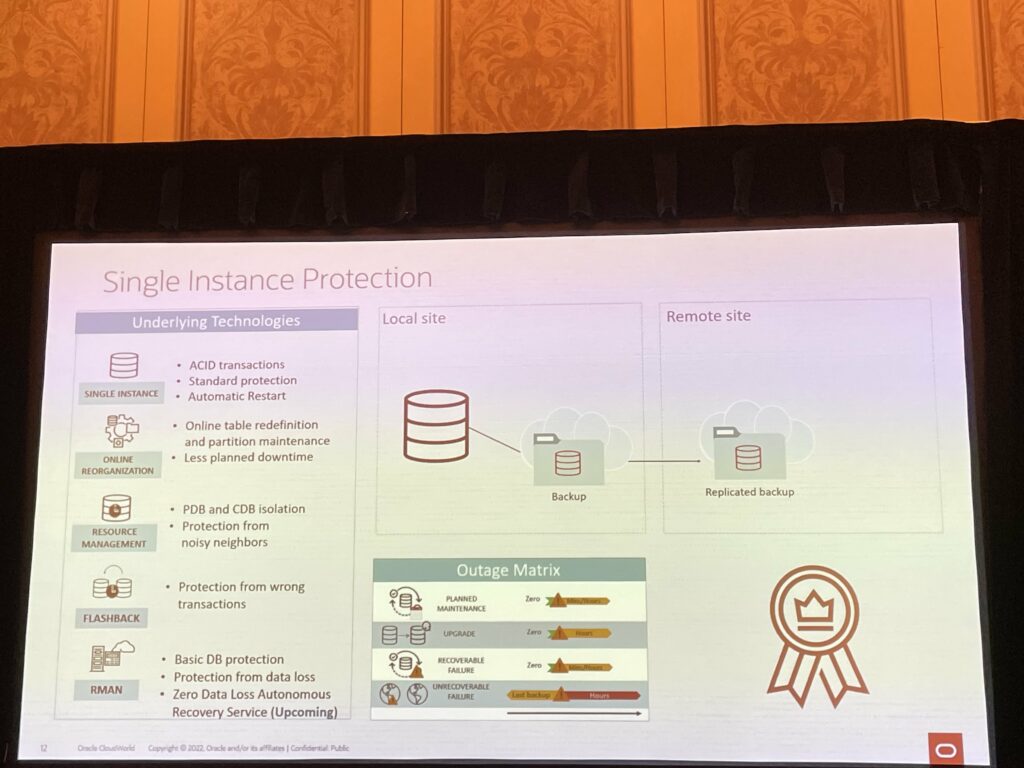
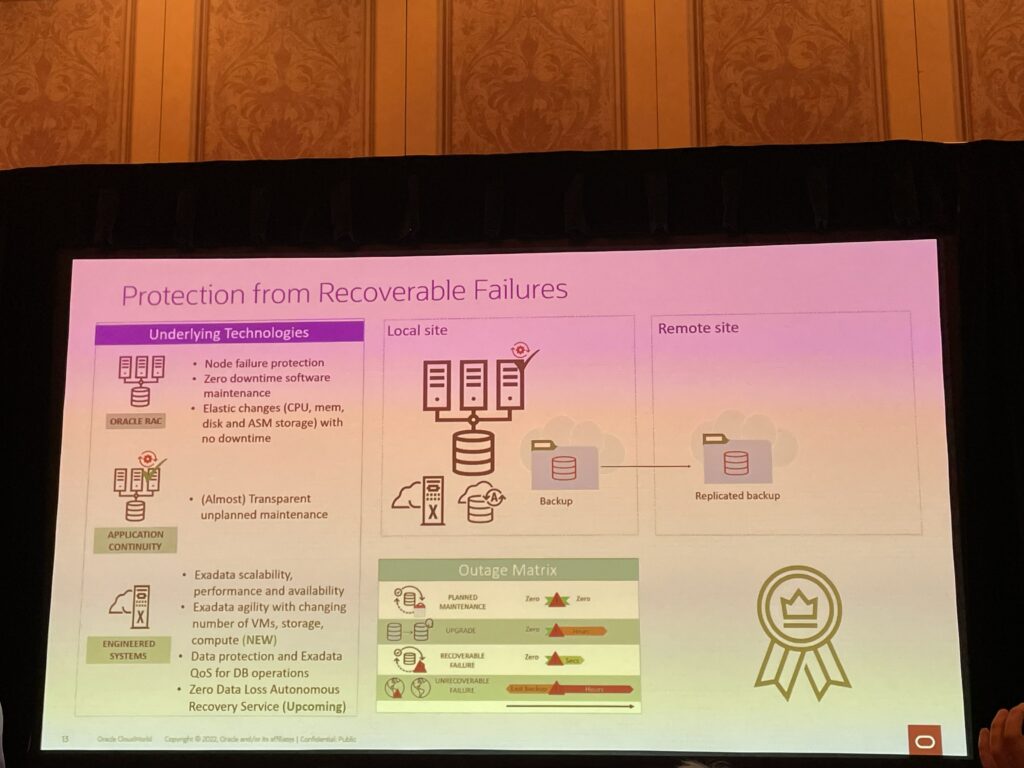
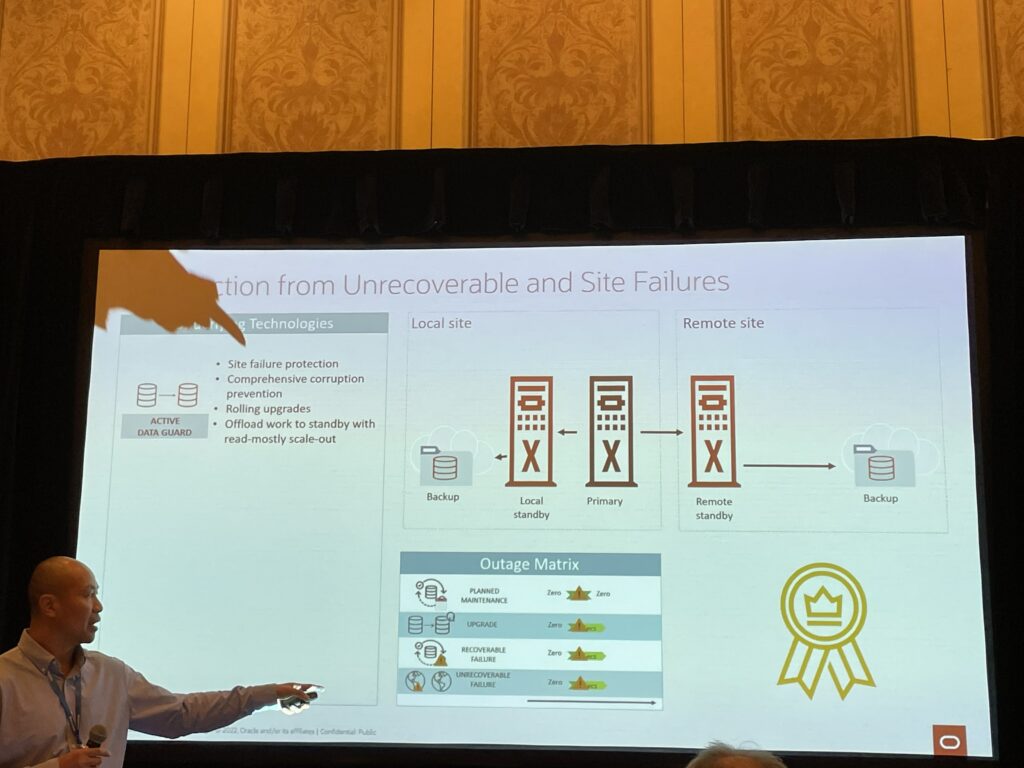
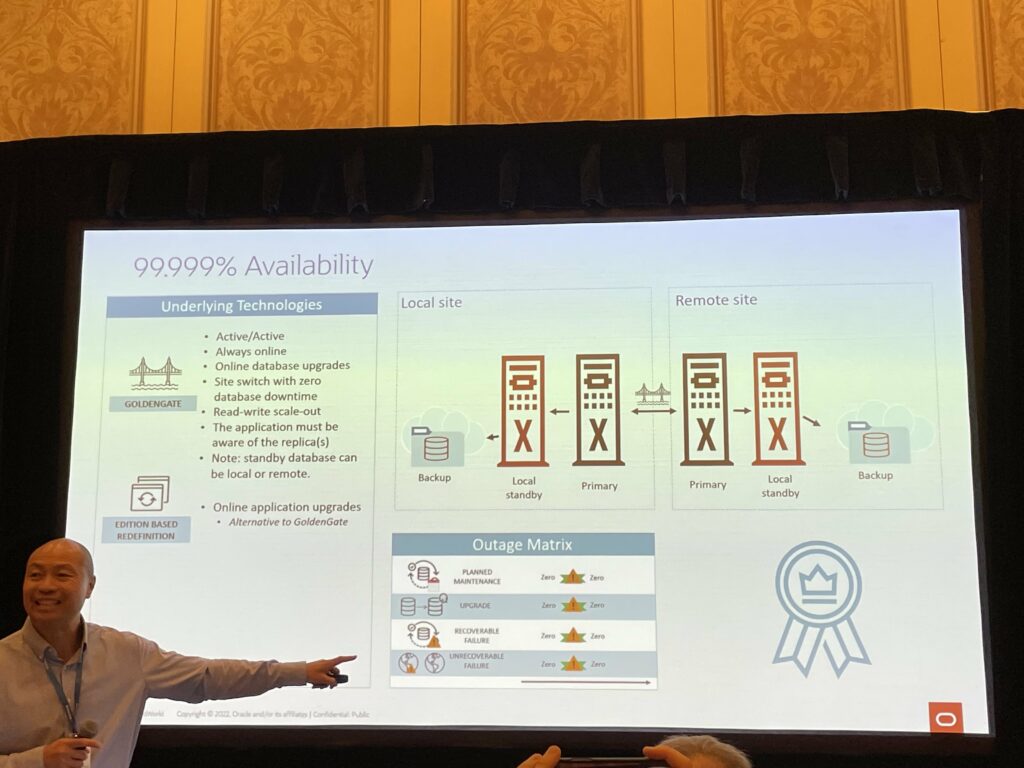
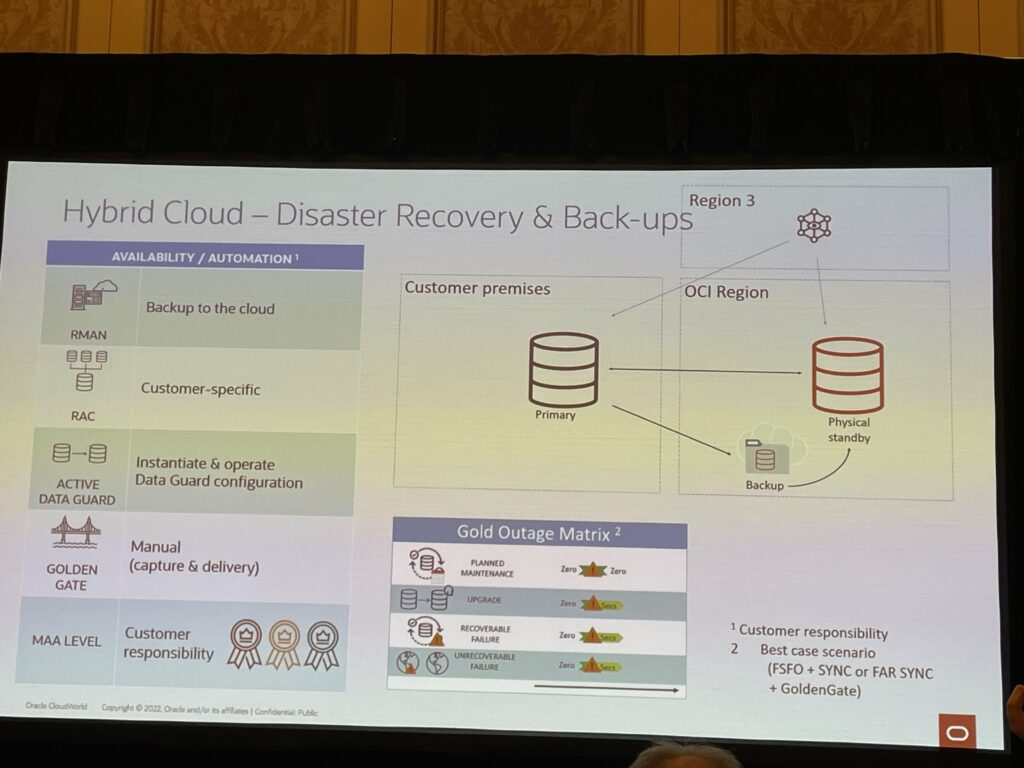
Customer Bronze and Silver MAA Cloud Best Practices
- Use Exachk – MOS 1070954.1
- Review and Enable Database Service Events
- Invest on Application failover readiness
- Take backup consideration, see MOS 2809393.1
- Understand and prepare for Cloud software updates (invest in application failover readiness, understand application graceful draining options, check cloud infrastructure software updates as RAC rolling on exadata database host, rolling with zero database downtime, Database guest software updates on OS, database grid infra and database upgrade with dbms_rolling)
In the future fleet patching might be a future integrated solution to MAA.
Customer Gold MAA Cloud Best Practices
- Configure Standby AWR
- Use Data Guard Broker validate command in weekly basis
- Decide on application failoveror or site switch for DR
- OCI having high bandwidth networks, redo transport tuning might not be required
- If apply lag > 10s then use redo apply troubleshooting and tuning guide
- If apply lag > 6 hours, then roll forward a standby database using recover database from service (Doc ID D2850185.1)
Futre MAA integration: Fast-Start Failover more ADG health and auto repair
Future MAA cloud solution : PDB failover for DR and DR test
PDB relocate operations… I need to test this as soon as I can!!!
19c PDB Migrate solution enables PDB role transitions MOS 2887844.1. Good to know!
Customer Platinum MAA Cloud Best Practices
- Use GoldenGate
To conclude this session, here is a nice comparison:
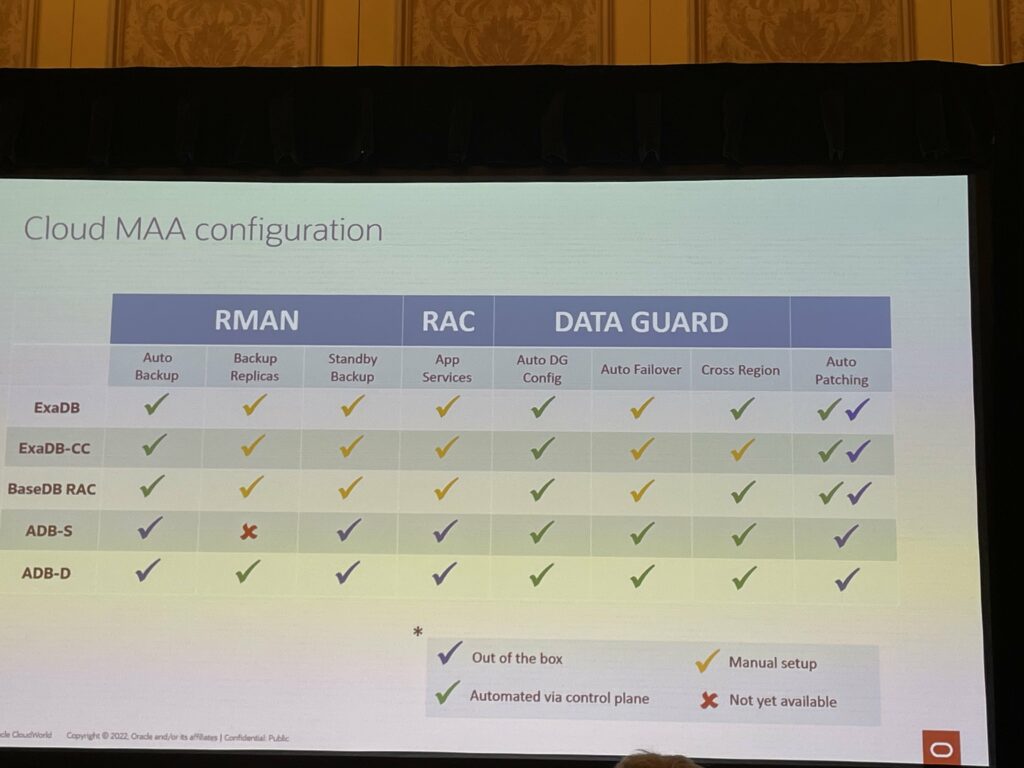
Oracle Autonomous Database: Simplify Your Database Management [LRN1471]
I also joined a session provided by Yasin Baskan and Marcus Praetza. Marcus from Deutsche Bank AG provided feedback about their experience and need in on-premises Oracle Cloud Solution.
Yasin then introduced some Oracle Autonomous Database (ADB) functionalities.
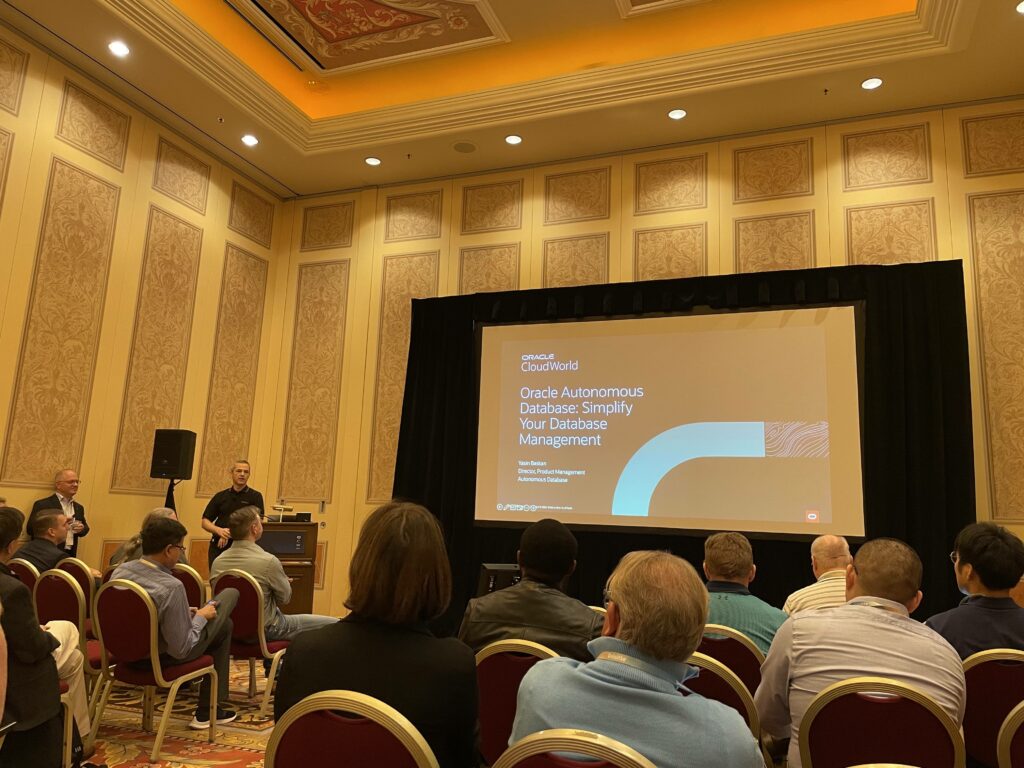
Oracle Autonomous Database is a complete infrastructure automation + a complete Database automation + automated Data Center operations + built-In Tools.
It is available in the oracle public cloud, exadata cloud @customer, dedicated Region Cloud @customer and hybrid cloud configurations
Pros:
- Regular new features coming
- Support all integration with anything else in the Cloud whatever provider it is
ADB is pre-configured differently according we choose one of the possible following options:
- ADW : Autonomous Data Warehousing
- ATP : Autonomous Transaction processing
ADB for APEX App DEv and Autnonomous JSON Database (AJD)
We can count 22000 databases provisioned each month, time of provisioning is 2 to 3 minutes.
Scalability
- Instant online, auto scale up to 3x online and instantly and only pay for what you use. No fixed shapes.
Reliability
- High available clustered infrastructure
- Provisioned on exadata hardware, everything is redundant
- Automatic recovery for compute/storage failures
- Cross availability domain and cross region replication for Disaster Recovery
- Easily deploy a standby database for Data Guard
Autonomous Data Guard
- Simple and transparent Data protection
- Easy to enable, one click
- Easy to switch, one click to switch over or failover
- Automatic local failover with zero data loss is also possible
RTO/RPO for autonomous Data Guard
- Local : RPO 1 min RTO 2 min
- Cross region : RPO 1 min RTO 15 min
- Roadmap RPO of 0 with maximum availability mode. Multipe remote standbys
Autonomous Database SLA
- 99.95% for availability
- 99.995% with autonomous Data Guard
Autonomic detection of issues : 87.7% of the SRs are filed automatically
Patch Management
- 75% DA time spent on patch management, now ADB is doing it itself.
- 4+ Million of patches was automatically applied in the last 12 months without downtime
- Automatic patching with no database downtime.
- Announced weekly maintenance schedule
- Roadmap : Flexible maintenance windows
Backup and recovery in ADB
- Fully automated backup. RPO 1 min
- Restore in place or out of place : 60 Day of retention
- Flashback Table and Query. Roadmap : Flashback Time Travel
- Free. Roadmap: Long-term Backup retention
All types of cloning : DEV/TEST Copies from production
- Easy to create clones
- Refreshable clones (on demand) for continuously replicated data
- Roadmap : Snapshot standby for read-write workload testing
Interoperability
- Secure and easy access from autonomous database to all data lakes
- Use vendor specific cloud access policies to control access
- Built-in gateways to non-Oracle databases (Mongo DB, MySQL, …), free of charge. Simple API to create db links.
- Oracle Database Service for Azure. For free, link Azure tenancy to OCI, private interconnect and networking.
Data sharing will soon be supported with ADB.
Playing at the casino
Finally I had a last session…. at the casino. And I had no luck. I did not become billionaire and lost my 3$.

![Thumbnail [60x60]](https://www.dbi-services.com/blog/wp-content/uploads/2022/08/MAW_web-min-scaled.jpg)
![Thumbnail [90x90]](https://www.dbi-services.com/blog/wp-content/uploads/2024/01/HME_web.jpg)
![Thumbnail [90x90]](https://www.dbi-services.com/blog/wp-content/uploads/2022/11/NIJ-min-scaled.jpg)
![Thumbnail [90x90]](https://www.dbi-services.com/blog/wp-content/uploads/2024/04/SIT_web.png)
![Thumbnail [90x90]](https://www.dbi-services.com/blog/wp-content/uploads/2022/08/JEW_web-min-scaled.jpg)